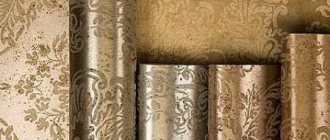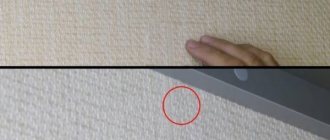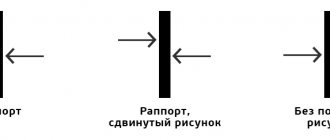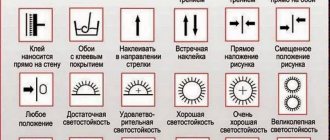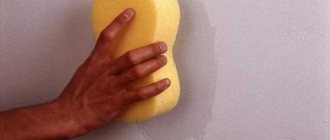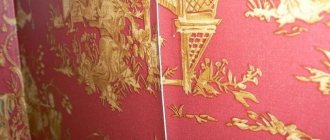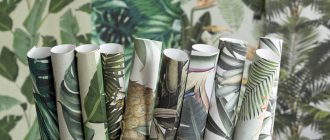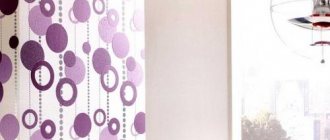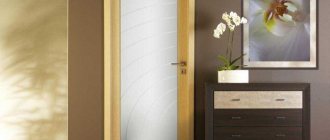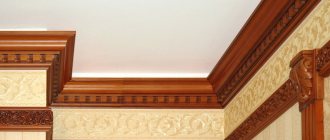How to remove coffee from a white wall?
Pour fine table salt into a bottle and heat the bottle with glycerin in hot water. Soak a cotton swab or soft cloth with this glycerin and wipe the coffee stain off the wall, just be careful not to damage the paint. The glycerin should dissolve the coffee and remove the stain from the wall.
Interesting materials:
What does the cross on the dome of the temple mean? What does a cross with a crucifix mean? What does imitation shrimp mean? What does a circle in a square mean? What does a steep dive mean? What does wing mean? What does a dragonfly pendant mean? What does the square on the tube mean? What does a square bracket mean in a system of equations? What does technician qualification mean?
Wallpaper of a different color
The easiest option is to replace the damaged piece of wallpaper. It’s good if after the last repair there was a spare roll of the same color. Carefully cut the damaged piece from the wall and glue a new one. If there is a pattern, make sure it matches.
When there is no stock left, select similar or contrasting wallpapers and make an insert from them. How exactly to glue depends on the location of the defect and the imagination of the craftsman. You can use whole canvases or small pieces. The inserts can be horizontal, along the entire length of the room, or vertical, in one or more stripes:
- Was the wallpaper below torn off by cats, painted on by small children? Stick others, height from the floor and to a place just above the damage. For example, if the entire wall is decorated with small flowers, put striped wallpaper underneath, matching the color or plain;
- Is there a long horizontal scuff left in a visible place from furniture, such as a crib? Make a wide border of wallpaper;
- if a large area has been badly damaged, cover the wall with bright pieces of old wallpaper using the patchwork technique. This is done according to the same principle as patchwork quilts are sewn. Select and arrange them on the wall. You can combine different textures and patterns in the same color scheme, different palettes of the same theme (for example, floral), sizes and shapes of fragments;
- Vertically applied stripes of contrasting color wallpaper will not only hide defects, but will also become a bright accent on the wall. They can even be glued to the ceiling. And if you decorate it with polyurethane moldings, you will get an original panel.
Features of wall decor in the interior of an apartment
The unique wall decor in the apartment speaks about the style, taste and creativity of the owner. To create a beautiful and harmonious interior, you need to arrange not only exquisite furniture, but also use original decoration.
Thanks to the wide range of finishing materials and various decoration means, it is easy to decorate any room in a variety of styles.
Wall decoration performs several important functions:
- Aesthetic. Wall decor in an apartment, photos and ideas of which are easy to find on the Internet, is first and foremost a decoration of the room.
- Creating a rare design. The originality of the design can be shown by the walls if they are decorated with handmade crafts.
- Informative. If you decorate the walls with photographs and paintings, you can clearly show who is part of the family.
- Masking. You can easily hide finishing imperfections with the help of decor. As an example, a hole in the wall can be easily hidden behind a picture.
- Economical. Sometimes a new accent in the interior will help delay the renovation for a while.
When making repairs, you need to especially think through the design of the walls, since the finishing should be environmentally friendly, have a less expensive and simple application technology.
Useful tips and how to fix errors
Before gluing the canvas, it is necessary to prepare the surface. If the wall has undergone repairs and the application of gypsum putty, it is necessary to apply a primer, it is best to take ST17 or its equivalent. This will significantly reduce adhesion - reduce the absorption of the surface. The glue will not dry instantly or unevenly. If the walls have been cleaned of previous wallpaper, you also need to apply a primer only after thoroughly removing the previous material.
Important: It is best to choose a glue with a composition that allows you to adjust the canvas when gluing. These data are indicated by the manufacturer on the packaging of the roll or the information can be provided by the salesperson in the store. If it is recommended to dilute the glue for glass wallpaper in a smaller proportion than for non-woven or vinyl, it is better to stick to this consistency
Thicker glue is always easier to adjust when gluing
If it is recommended to dilute glue for glass wallpaper in a smaller proportion than for non-woven or vinyl, it is better to stick to this consistency. Thicker glue is always easier to adjust when gluing.
The first strip must be aligned in accordance with the marked landmark and in an area without corners or other openings. Leveling should be done using rubber or plastic spatulas, rollers or a soft cloth. In this case, movements should be from the center up and to the sides, and then from the center down. But not horizontally, but as a “herringbone” is drawn - this will more effectively expel the air and connect the canvas to the surface.
Do not allow the canvas to bend sharply, as this will make the problem area vulnerable to tearing and with a visible defect. If the bubble cannot be removed, then you need to peel off the strips to the required height and re-glue it, starting from the problem area.
Due to the slight expansion of non-woven fabric as a result of contact with liquid, it is best to glue the fabric with a slight overlap. It will then separate as the glue dries, and no gaps will be visible. The excess is cut off with a wallpaper knife using dry material.
It is very difficult for one person to paste wallpaper while noticing all the nuances in a timely manner. Therefore, if you have no experience in this matter, it is better to enlist help. If two people level the canvas (one on top and glues the first 20-30 cm, and the second simply does not allow the rest of the strip to stick to the wall), then the process is greatly simplified and the number of bubbles is reduced to a minimum.
If, as a result of gluing, several small bubbles still form, they can smooth out on their own after a couple of days. If this does not happen, then you can release the air without damaging the decorative layer by puncturing it with a needle or medical syringe. Excess air is simply sucked out of the defect cavity.
When gluing non-woven or vinyl wallpaper, bubbles or wrinkles may appear. To eliminate them, you don’t need to panic or immediately change the material. It is enough to peel off the canvas and try to adjust it so that the defects are eliminated.
High-quality material, following gluing technology and selecting the right adhesive composition will reduce the problem to a minimum. If, after gluing, the wallpaper wrinkles, the creases can be eliminated by trimming or puncturing and re-gluing the problem area.
Fighting the edges that have risen up like a house
Not the most difficult, but quite common case when joints rise and twist, photo. Usually craftsmen in such a situation, in order to hide their imperfections, blame the quality of the wallpaper and poor glue. In fact, the problem lies precisely in the lack of professionalism of the workers. In the process of coating the cloth, experienced craftsmen apply glue to the edges twice, because the adhesive mass dries much faster along the edge of the cloth. To hide the raised joints, just apply an additional layer of adhesive under the seam line and roll the trellis with a rubber roller.
It is much more difficult to hide a defect at the joints in a situation where the seams have risen along with pieces of soil and whitewash. This means that the preparation of the wall surface was carried out extremely carelessly, and when shrinking, the wallpaper tore off the adhesive seam at the joint. In this case, you have to spend a lot of time soaking and removing the old glue from under the joint, and only then gluing and rolling the fabric. If you try to re-glue the seams as they are, the remnants of the old glue and whitewash will make the seam stand out, and under certain lighting the defect will appear in a new way.
How to choose the most suitable means of transforming walls?
When thinking about how to decorate a wall with your own hands, you have to carefully analyze everything:
- room dimensions;
- free surface area;
- your artistic abilities;
- the scale of transformation of a room or apartment.
If there is no stylistic reference to the interior, and major renovations have already been completed or are not yet planned, it is important to highlight your preference in what style to decorate the apartment. A wall panel or mosaic can highlight the choice of style, and a few accessories and a curtain pattern will complement the atmosphere.
A pattern of dishes on the wall in the kitchen will look harmonious in the interior
The process of creating a picture on the wall
The chosen theme of the image or bright accent may be a typical expression of a certain style:
- retro (vintage, shabby chic, grunge);
- minimalism (constructivism, functionalism);
- country (Provence; chalet; ranch, tower);
- urban styles (loft, techno, futurism);
- modern style (fusion, contemporary, hi-tech);
- ethno (African, Asian - Japanese, Indian, Chinese, Arabic);
- classical and historical styles (antique, palace, renaissance, baroque).
If it's time to choose your own style, don't chase fashion or adopt someone else's lifestyle. Imagine this or that design example in your apartment or house - will it be comfortable to live in such an environment? Sometimes original wall decoration with your own hands causes some rejection and rejection. On the contrary, some well-executed idea that is close to the heart will fill your personal space with a special aura. But it happens that you are simply tired of everything, and you want to dilute the trivial atmosphere with unusual decor on the wall, as in the photo.
You can paint fruits on the wall in the kitchen
You can make a collage of many paintings on the wall
You can make a collage of paintings on the wall
The designer by vocation considers any free wall as a blank canvas for the upcoming transformation of the interior. But DIY home decor in an apartment can solve other problems:
- get rid of inept children's “art”;
- hide wall defects (stains, smudges, sagging, cracks, holes, unevenness);
- tidy up the most problematic wall so as not to do general repairs;
- add some zest to the interior design;
- visually expand the space.
Decorating the walls in an apartment with your own hands is associated with creative self-realization; it is a fascinating process. But it is advisable to master the secrets of craftsmanship or choose an accessible method of original wall decoration. Don't overdo it when choosing decoration methods. It is better to do one thing, but impressive, than many small techniques that distract attention.
Wall decoration can be made from large tiles
Such wallpaper in the interior looks practical
Wall art
Wall painting looks expensive and impressive. The most relevant in this direction are plant and animal motifs. Being a combination of photo wallpaper and stencil pattern, the decor of this option allows you to decorate the room and leaves complete freedom for creativity. The applied drawing can be either monochrome or color, single (on one area) or on the entire wall. Be individual or complement another design solution.
The sketch of the composition is applied to the wallpaper using a pencil and is gradually filled with color using brushes of various materials and sizes. In order to highlight individual elements, you can use paint with a shimmering effect.
How to hide a joint contaminated with glue
Excess glue at a joint is the simplest case, but only under one condition, if you pay attention to the problem in time. If the wallpaper is glued by hired craftsmen, you will need to check the quality of the work in the first hours, while the glue is still wet.
On vinyl or non-woven wallpaper, it is enough to simply wipe the glue with a dry and clean napkin; on paper, excess adhesive material is blotted, like an ink stain, without rubbing on the canvas. After the wallpaper has dried, the joints must be checked again, since over time, glue stains tend to turn yellow and appear in the picture, after which it will be impossible to hide them.
On dark wallpaper, residual glue at the joints can be hidden using a retouching pencil. Before decorating the seams on the wallpaper in the photo, the marks are wiped off with a paper eraser.
Basic options and ideas for wall decor
There are many ways to decorate walls. There are even more options when it comes to decorating the walls in your apartment.
When choosing a color, you should consider how it will influence human psychology and the overall harmony of the space.
Decorative and textured plaster
This option is great for an unusual design. The mixtures consist of cement and stone chips.
It can be a self-sufficient type of finishing or can be combined equally well with other materials.
Textured or relief plaster can be applied using different methods. Thanks to this, the drawing can differ either as whole fragments or as a large picture.
Is it necessary to apply tape to the joints of wallpaper?
It is needed when there is a risk of stretching the wallpaper when applying stickers. And this happens when the walls are poorly stretched, there are pits and bumps that will give excessive tension, which will lead to the wallpaper spreading. ... Check tape is glued at the joints of the wallpaper (under them, of course) so that those same joints do not come apart.
Interesting materials:
Is it necessary to form a begonia? Do you need to iron Chinos? Do curtains need to be ironed? Do I need to prime a wooden surface before painting? Do I need to prime my car before painting it? Do I need to prime walls between coats of paint? Should I take a shower after working out? Is it necessary to index benefits for up to 15 years? Should clover be mowed? Do I need to paint before liquid wallpaper?
Panels or paintings
When there is an awkward spot or hole in the central part of the wall, the classic way to get rid of it is to cover it with a painting, framed photo or decorative panel. You can buy all this in a store, or quickly and inexpensively do it yourself, decorate it effectively and beautifully:
- panels made from leftover wallpaper are a fashion trend. Make it on a separate surface or stick it directly to the wall. Use a separate bright piece of wallpaper or combine several pieces. Choose an interesting frame from any suitable material. Use an interesting technique - decorate an applique made directly on the wall with a frame made of plastic moldings, painting it in a contrasting color;
- a picture from photo wallpaper - easy to make with your own hands. Cut out a piece of photo wallpaper that suits the size and subject, stick it on a cardboard or plywood base, and hang it in the chosen place. Using this technology, you can create not just one picture, but entire modular compositions consisting of several segments. Their number is limited only by your imagination and the availability of suitable materials. They will help cover a large area of damage;
- paintings made from liquid wallpaper are another simple decoration technique. Plastic material will easily hide any defect: indelible stains, holes and even cracks. Make a preliminary pencil drawing using a stencil, and then apply the mixture. Use masking tape to limit the outline of the design.
Dark spots: causes and solutions to problems
This problem is perhaps the most serious, because if dark spots appear on the wall, this may indirectly indicate that mold may have appeared under the wallpaper. Therefore, if some time after sticking you begin to notice something like this, you will need to take urgent measures to immediately eliminate it.
Causes and solutions
Before you think about what to wash and how to decorate dark, sometimes even black mold stains, you need to know the reasons why such areas appeared on the walls of the room. Moreover, in the vast majority of cases, the fungus appears under the wallpaper, and not on it. In fact, there are three main reasons:
- Incorrectly performed repairs without antiseptic treatment.
- Poor microclimate in the room: high humidity and lack of airflow and ventilation.
- Pasting on a rough wall (for example, on top of plaster), without preliminary preparation and priming.
In any of the above cases, it is necessary to remove the old wallpaper surface. Without this, no antifungal agent will help you. And even if it helps, it will only be for a while, after which dark mold spots under the wallpaper will appear again. So, to solve the problem, it is necessary, first of all, to create a favorable microclimate in the room. Then you need to perform some actions. So, here are the detailed instructions:
- Temporarily remove furniture from the room and treat it with a sponge or cloth soaked in hydrogen peroxide.
- Completely remove old wallpaper from the walls.
- Prepare the surface by sanding it down.
- After this, remove the dust, or even better, thoroughly wash the work surface.
- Apply a mildew and mold preventative to the entire wall.
- Wipe the wall again with a damp cloth to remove dust and remaining materials.
- And only after additional application of primer with antibacterial and antifungal properties is it permissible to begin wallpapering.
Do not forget that when carrying out this work it is necessary to ventilate the room well. In addition, to ensure your own safety, use a special mask; this will protect your lungs and other respiratory organs.
How to get rid of yellow spots
Disposal with detergents
Using detergents is the easiest way to deal with yellow stains. It is ideal for moisture-resistant wallpaper and is contraindicated for paper wall coverings. Actions are performed in the following sequence:
- Wipe the wallpaper with a dry soft cloth. This allows you to clean the surface of the walls from dust accumulated on them and other debris.
- According to the instructions, detergent is diluted in the container. Using a sponge, the foam solution is applied locally to stains on the wallpaper.
- After a short period of time, the detergent is removed from the surface with a soft damp cloth
- The surface of the wallpaper is wiped dry; you can use a microfiber cloth for this.
Rips in corners.
Tears in the wallpaper occur when the corners of the room on which the sticker is applied are uneven. And also, because the wallpaper itself is too thin. The simplest way to get rid of this defect is to redo the work, i.e. re-paste the wallpaper in the corners.
To do this, you should follow the following sequence of work: you need to completely and carefully remove the strips of wallpaper from the corners where the deformation of the canvas has occurred, measure and cut a new piece of the required width and height, carefully coat the wallpaper strip with glue and stick it in the corner so that the corner overlapped by the edge of the canvas at least 10 centimeters wide. If the corner of the room is completely uneven, then after waiting for the glue to dry completely, make cross-shaped or straight cuts in the places of unevenness (depending on the type of unevenness). Then glue the cut parts so that the “relief” of the wall is maintained.
Other types of defects, such as, for example: mismatch of wallpaper pattern, curvature of the wallpaper, or a large accumulation of air bubbles, can only be corrected by completely re-gluing the wallpaper.
What to do if stains appear on the wallpaper after drying
At first glance, hanging wallpaper yourself seems like a trivial matter. But as soon as work begins on measuring, cutting the canvases, preparing the walls and adhesive solution, and then the time comes for proper and even gluing, ambitions will dissipate. After spending a lot of time, using all your most secret skills and finishing the work, you can sadly observe that stains have appeared on the wallpaper.
No. 2. Traditional method: removing wallpaper with water
The wet method works in most cases. Moreover, it is more hygienic compared to the previous option, since less dust will be generated during the process. The procedure is as follows:
prepare the room, seal the baseboard, sockets and switches; The essence of the method is to wet the wallpaper enough to soften the material itself and dissolve a significant part of the glue, so you need to prepare water. It is better to take warm water, and to be sure, you can add a little soap, dishwashing liquid or fabric softener to it. These substances will significantly speed up the process; It is best to wet the wallpaper with a sponge (but you can use a spray bottle, a spray bottle, a rag, a roller), trying to apply enough liquid to soften the wallpaper and glue, but not overdoing it so that the water does not flow onto the floor or flood the sockets. After 20-30 minutes, you can begin to remove the wallpaper itself, until everything is dry. It is better to treat the surface in parts; For better penetration of water into the wallpaper and under the wallpaper, the top layer can be perforated using a needle roller, knife or wallpaper tiger. If the wallpaper has a protective moisture-repellent layer, then you can’t do without such a trick;
When the canvas is sufficiently saturated with water and begins to move away a little from the surface, you can pry it up with a spatula and begin to tear it off. Better to tear it off from the seams
If some areas are stubborn, re-wet them; the edges of the spatula should be sharp, so they can be pre-sharpened with sandpaper; take special care when removing wallpaper near sockets, switches and meters; if some areas still do not give in, you will have to arm yourself with a scraper, just work carefully so as not to damage the layer of plaster; Experts advise using laundry soap when removing wallpaper that was glued with PVA. Grate the block, add 4 liters of water and boil
An alternative is 9% vinegar: 450 ml per bucket of water will be enough. If you add both vinegar and soap, you can get a product that can even cope with wallpaper that is ingrained into the wall. To remove waterproof wallpaper, add fabric softener to warm water at the rate of 300 ml per bucket of water; Immediately put all removed fragments into bags or sacks. After finishing work, wipe the walls with clean warm water and a sponge.
This method is ideal for paper wallpaper: single-layer wallpaper soaks in literally 5-7 minutes and can be easily removed from top to bottom; double-layer wallpaper will take 10-15 minutes, and only the top layer can be removed. If you are going to glue wallpaper, then you can leave the bottom layer of the old ones. If not, then the procedure will have to be repeated. In the case of paper wallpaper covered with a protective moisture-resistant film, as well as in the case of vinyl, non-woven and washable wallpaper, you will have to try a little more. At a minimum, perforate, and at a maximum, use special compounds and other tricks.
Game of contrasts
A beautiful and effective decor is obtained by combining wallpaper of various contrasting shades. The decoration made with wallpaper of the same pattern, but in different colors, looks good.
It is best to choose the place for gluing contrasting stripes so that they frame or highlight the advantages of the furniture or room. For example, you can select an area for the location of a chest of drawers, a sofa or a bed. Or, marking the middle of the wall with colored stripes, decorate the decorated area with panels, photographs or small paintings.
To create such a decor you will need:
- a roll (or several) of wallpaper;
- wallpaper glue;
- brush;
- rubber roller for smoothing wallpaper;
- narrow stucco molding for framing (length equal to double the height of the ceilings);
- polyurethane glue;
- roulette;
- ladder.
It is very important to make symmetrical markings along the floor and ceiling lines before starting work. It is important to remember that the width of the area to be decorated must be a multiple of the width of the wallpaper roll!
You can start gluing from any edge, carefully smoothing out air bubbles and avoiding distortions. Decorative stucco is glued to the sides after the wallpaper has dried, masking the junction of two colors. Polyurethane glue sets quickly, and the plank does not require additional fixation. This vertical division of the plane visually expands the space and creates a more comfortable environment.
Reasons for appearance
All stains on wallpaper can be divided into two types:
- Stains that appeared immediately after gluing. This category includes stains caused by mold, mildew, or rust.
- Stains that appeared during use. These include greasy stains, dead insects, marks from pens, markers and other colored objects.
Traces belonging to the first category appear within two to three weeks after repair. Why do they show through? The reasons may be the following:
- Improper use of primer.
- Mistakes in using wallpaper glue, for example, using a pre-diluted adhesive composition.
- Improper preparation of the surface of the ceiling and walls for wallpapering. So, any rusting pin in a concrete surface can lead to stains on the wallpaper.
Attention
No one is immune from the appearance of traces during the operation of the apartment. They can appear as a result of children and animals playing, careless rearrangement of furniture, etc.
Options and ideas for wall decor in the interior of an apartment
Did you like the article? Follow new ideas from the world of construction, design, and useful tips in our channel. Subscribe to us in Yandex.Zen. Subscribe.
Decorating a room is one of the most enjoyable moments in renovation. Even minor changes can give rooms a new, fresher look. You can transform a room using many available tools. This will not only free up your imagination, but also provide an opportunity to spend time usefully.
The design of the walls in the apartment is the key point of the entire interior.
Grease stains on the wall
Despite the fact that greasy stains significantly spoil the appearance of the room, they are not the phenomenon that leads to complete re-gluing of the paintings on the walls. The most common reasons that provoke their appearance may be:
- Food getting on the surface.
- Contamination due to carelessness.
- Walls can get dirty by children, especially in a children's room.
In economic practice, there are several ways in which you can get rid of such stains. A caveat should be made: each of these methods will be effective only with a certain type of material from which the canvases were made. So let's talk about each of them.
Light wallpaper
Light wallpapers are traditionally classified as both paper and fabric wallpapers. They are the type of material that absorbs fat, which makes the task somewhat more difficult. However, it is quite possible to clean them. The first method is the so-called. “thermal”, during which you need to apply a clean paper napkin to the problem area on the wall, and then carefully walk over it with an iron. However, this method does not help in all cases. Don't worry, you can use gasoline for this.
So, for this you will need:
- Take 1 tbsp. starch powder and mix it with ½ tbsp. (about 5 ml.) gasoline.
- Apply the resulting solution to the problem area and leave for a while (let's say 2-3 hours, maybe less).
- The gasoline must evaporate completely before you begin scrubbing the grease stain using a brush or similar device.
One of the above methods should clearly be effective and help you remove grease stains.
Heavy wallpaper
Traditionally, this category includes both non-woven fabrics and vinyl wallpaper. This type of material differs in some features, thanks to which it is somewhat easier to remove stains from its surface than from lighter paper or textile ones.
As a rule, in most cases it is quite sufficient to simply take and wipe the contaminated area with an ordinary clean rag. If this does not help, then apply a little cleaner to it and try again.
Attention! To avoid damage to the outer layer, the rag should not be too hard. At the same time, when cleaning, try to move from the center of the contaminated area to its middle, thus not spreading all the grease beyond the stain itself.
Glue the paper edging
If the edges of the wallpaper along the ceiling or floor have become peeled off, stained, damaged by water, or become unsightly for any other reason, they can be masked off. To do this, just stick a paper edging of a suitable width over the wallpaper.
It can go along the baseboard (even the ceiling).
The edging can be cut from the same wallpaper, although stores sell ready-made options for every taste. If you choose an edging of a suitable color, then such a solution can turn out to be an interesting and original interior find.
